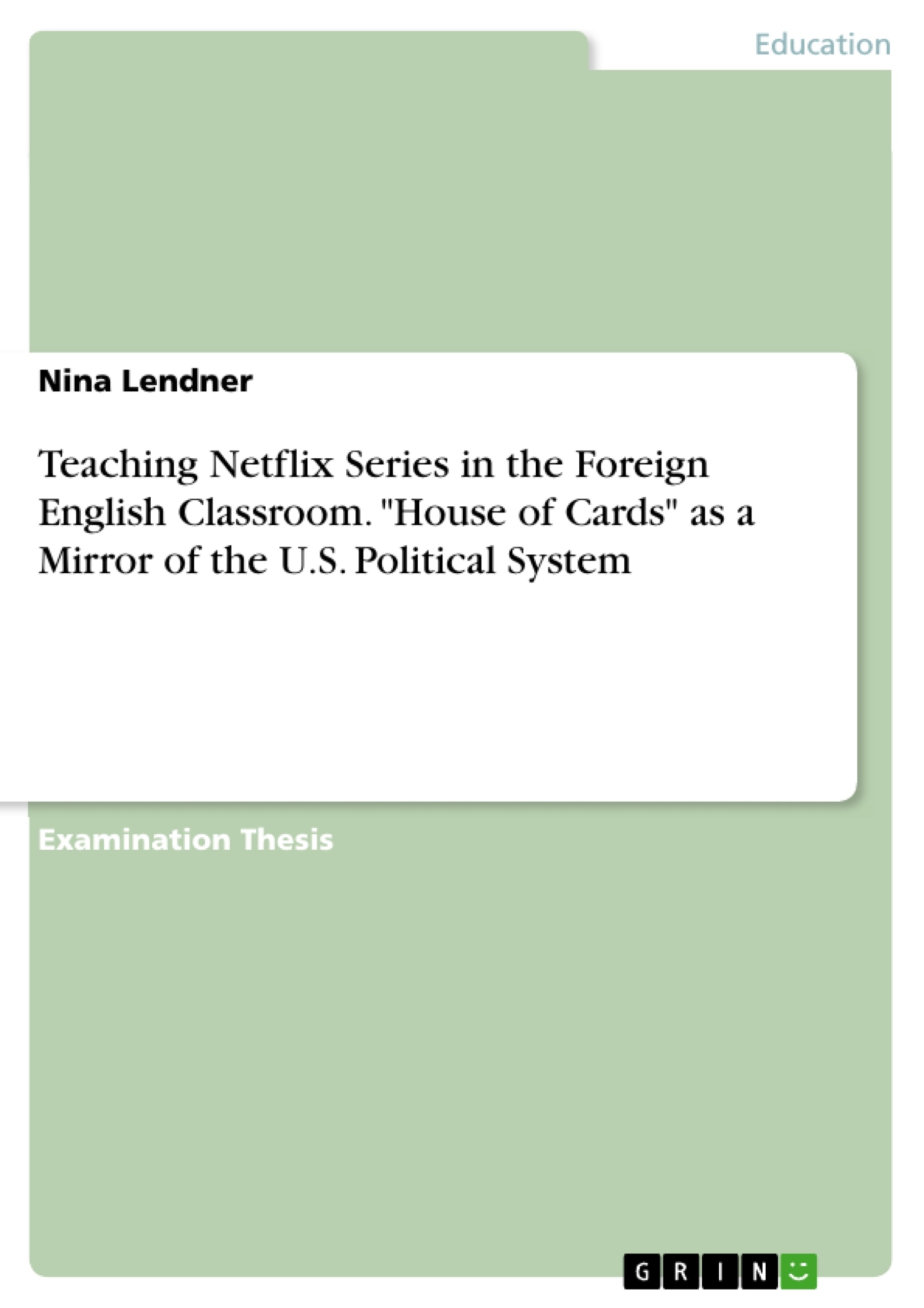The intention of this paper is to show possible applications of the Netflix original series House of Cards as a mirror of the U.S. political system, which foster film literacy within teaching English as a foreign language (TEFL) and how learners profit from authentic texts as media literacy rather than on literary texts on intercultural topics. It starts off with the didactic value of films as TEFL devices, define film literacy as an aim in learning and a presentation of approaches and methods of teaching film as media literacy. The special focus will be on the first season of House of Cards, providing a summary of its plot as well as a complete lesson concept on teaching the political system of the United States of America in a 12th grade A-level standard (gymnasiale Oberstufe) class. This concludes example exercises to bridge the gap between the didactical value and the theoretical methods and their implementation for the use of the Netflix series in the TEFL classroom, and covers a case study with analysis to the first season as well as film language and intertextual and intercultural challenges.
Inhaltsverzeichnis (Table of Contents)
- Introduction
- Film Education in Teaching English as a Foreign Language
- The History of Film Based Language Learning in the TEFL Classroom
- Film Based Language Learning with its Didactic Value in the TEFL Classroom
- Development of Communicative Competences
- Intercultural Learning
- The Didactic Value of Audio-Visual Media in the TEFL Classroom
- Practical Facets in Teaching Audio-Visual Media - Criteria for Film Selection
- The Impact of Film Literacy in Teaching English as a Foreign Language
- Lütge's Four Dimensions of Approaches on Film Education
- Motivational Affective Dimension
- Language Learning and Competence Development Dimension
- Aesthetic and Formal Dimension
- Intercultural Dimension of Language Learning
- Cognitive Approach by Wharton and Grant
- The Consideration of Different Didactic Approaches on Film Based Language Learning
- Lütge's Four Dimensions of Approaches on Film Education
- The Didactic Value of the Netflix Series House of Cards - Using House of Cards as a Case Study in the ELT Classroom
- Students' and Instruction Setting
- Lesson One - What Do We Really Know About Politics in the U.S.? An Introduction
- Lesson Two and Three - The Political System of the United States
- Lesson Four - The Road to the White House
- Lesson Five - America's Gun Culture
- Lesson Six - Film Analysis and Introduction of the Case Study - House of Cards as a Mirror of the U.S. political system
- Lesson Seven to Eleven - Case Study
- Lesson Twelve and Thirteen - Evaluations and Presentation of the Case Study
- Lesson Fourteen - Excursus: Bush vs. Kerry - Different Views on the Iraq War
Zielsetzung und Themenschwerpunkte (Objectives and Key Themes)
This paper aims to demonstrate the potential applications of the Netflix original series House of Cards as a reflection of the U.S. political system, fostering film literacy within the realm of teaching English as a foreign language (TEFL). The paper explores how learners benefit from authentic texts as media literacy, rather than solely relying on literary texts on intercultural topics.
- The didactic value of films as TEFL tools
- The role of film literacy in language learning
- The application of media literacy approaches in the TEFL classroom
- The use of the Netflix series House of Cards as a case study for teaching the U.S. political system
- Intertextual and intercultural challenges in film analysis
Zusammenfassung der Kapitel (Chapter Summaries)
The introduction highlights the significance of film as a medium in the 21st century, emphasizing its role in shaping cultural values and serving as a guide for young people. It underscores the importance of audio-visual aids in reflecting the zeitgeist and shaping views and attitudes. This section also discusses the increasing use of audio-visual media in the TEFL classroom, highlighting the benefits for both teachers and learners.
Chapter two delves into the history of film-based language learning in the TEFL classroom, tracing its evolution from the 19th century to the present. It discusses the shift from a focus on literary texts to the inclusion of audio-visual media, particularly in the context of developing communicative competencies and intercultural understanding.
Chapter three examines the impact of film literacy in language learning, exploring different theoretical approaches to film education. It emphasizes the various dimensions of film education, including the motivational, linguistic, aesthetic, intercultural, and cognitive aspects.
Chapter four explores the didactic value of the Netflix series House of Cards as a case study for teaching the U.S. political system in a TEFL setting. It outlines a lesson plan, detailing the specific learning objectives, activities, and assessments. The chapter also addresses the challenges and opportunities of incorporating film language, intertextuality, and intercultural perspectives in the analysis of the series.
Schlüsselwörter (Keywords)
The key terms and focus topics of this paper include film education, TEFL, media literacy, intercultural learning, authentic texts, film analysis, House of Cards, U.S. political system, and intertextuality.
- Quote paper
- Nina Lendner (Author), 2021, Teaching Netflix Series in the Foreign English Classroom. "House of Cards" as a Mirror of the U.S. Political System, Munich, GRIN Verlag, https://www.grin.com/document/1262965



